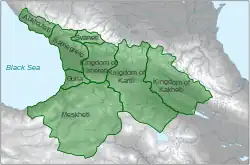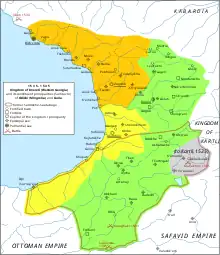Kingdom of Imereti
The Kingdom of Imereti (Georgian: იმერეთის სამეფო, romanized: imeretis samepo) was a Georgian monarchy established in 1455 by a member of the house of Bagrationi when the Kingdom of Georgia was dissolved into rival kingdoms. Before that time, Imereti was considered a separate kingdom within these Kingdom of Georgia, of which a cadet branch of the Bagrationi royal family held the crown.[1]
Kingdom of Imereti იმერეთის სამეფო | |||||||||||||||||
|---|---|---|---|---|---|---|---|---|---|---|---|---|---|---|---|---|---|
| 1260–1810 | |||||||||||||||||
 Final coat of arms of the Kingdom of Imereti.
| |||||||||||||||||
 The Kingdom of Imereti in 1490 | |||||||||||||||||
| Capital | Kutaisi | ||||||||||||||||
| Common languages | Georgian | ||||||||||||||||
| Religion | Eastern Orthodox Christianity | ||||||||||||||||
| Government | Monarchy | ||||||||||||||||
| King | |||||||||||||||||
• 1260–1293 | David IV (first) | ||||||||||||||||
• 1789–1810 | Solomon II (last) | ||||||||||||||||
| History | |||||||||||||||||
• Coronation of David I | 1260 | ||||||||||||||||
• Re-Annexation to Georgia | 1330 | ||||||||||||||||
• Restoration | 1387 | ||||||||||||||||
• Independence from Georgia | 1455 | ||||||||||||||||
• Vassal of the Ottoman Empire | 29 May 1555 | ||||||||||||||||
• Vassal of the Russian Empire | 25 April 1804 | ||||||||||||||||
• Russian Annexation | 20 February 1810 | ||||||||||||||||
| |||||||||||||||||
| Today part of | Georgia | ||||||||||||||||
| History of Georgia საქართველოს ისტორია |
|---|
.jpg.webp) |
|
|

The realm was conquered by George V the Brilliant and once again united with the east Kingdom of Georgia.[2] From 1455 onward, however, Imereti became a constant battleground between Georgian and Ottoman forces for several centuries, resulting in the kingdom's progressive decline due to this ongoing instability.
In 1621, Imereti made the earliest appeal for assistance to the Tsardom of Russia; in 1650 it acknowledged Russian suzerainty and in 1769 a Russian force expelled the Turks.[3] Under pressure from Pavel Tsitsianov, in 1804 Solomon II of Imereti accepted Russian Imperial suzerainty, only to be deposed entirely in 1810. During the time that Imereti was a vassal state, the Mingrelia, Abkhazia and Guria princedoms declared their independence from Imereti and established their own governments.
Kings of Imereti
First House of Imereti
- David IV (1258–1293)
- Constantine I (1293–1326)
- Michael (1326–1329)
- Bagrat I (1329–1330)
- Vacant (1330–1387)
- Alexandre I (1387–1389)
- George I (1389–1392)
- Vacant (1392–1396)
- Constantine II (1396–1401)
- Demetrius I (1401–1455), only recognized as Duke by Alexander I of Georgia
Second House of Imereti
- Demetrius II (1446–1452)
- Bagrat II (1463–1478)
- Alexander II (1478–1510)
- Bagrat III (1510–1565)
- George II (1565–1585)
- Leon (1585–1588)
- Rostom (1588–1589, 1590–1605)
- Bagrat IV (1589–1590)
- George III (1605–1639)
- Alexander III (1639–1660)
- Bagrat V (1660–1661, 1663–1668, 1669–1678, 1679–1681)
- Vakhtang Tchutchunashvili (1661–1663)[4]
- Archil (1661–63, 1678–79, 1690–91, 1695–96, 1698)
- Demetre (1663–1664)[4]
- George IV (1681–1683)[4]
- Alexander IV (1683–1690, 1691–1695)
- Simon (1699–1701)
- George V (1696–1698)[4]
- Mamia (1701–02, 1711, 1713)[4]
- George VI (1702–1707)[4]
- George VII (1707–11, 1712–13, 1713–16, 1719–1720)
- George VIII (1716)[4]
- Alexander V (1720–1741, 1741–1746, 1749–1752)
- George IX (1741)
- Mamuka (1746–1749)
- Solomon I (1752–1766, 1768–1784)
- Teimuraz (1766–1768)
- David II (1784–1789, 1790–1791)
- Solomon II (1789–1790, 1792–1810)
Heads of House of Imereti after 1815
Since Solomon II of Imereti had no sons, he proclaimed Prince Constantine, son of king David II of Imereti, and his male-line senior descendants as heirs to the throne of the Kingdom of Imereti.
- Hereditary Prince Constantine (I) (1815–1844), son of king David II
- Constantine (II) (1844–1885), son of Prince Constantine (I)
- Mikheil (1885–1888), son of Prince Constantine (II)
- George (I) (1888–1932), son of Prince Mikheil
- George (II) (1932–1972), son of Prince George (I), had no issue
- Constantine (III) (1972-1978), young brother of George (II)
- Princess Thamar (would have been Head of House from 1978), daughter of Prince Mikheil Imeretinsky (1900-1975), younger brother of Constantine (III)
After the death of Hereditary Prince Constantine (III) (1898–1978), because the male-offspring of this branch came to end, the headship of the House of Bagrationi-Imereti transmitted to Prince Irakli Bagrationi (1925–2013), son of Prince Grigol, the male-line descendant of Prince Bagrat, younger brother of King Solomon I of Imereti (1752–1784).
- Irakli Bagrationi (1925–2013)
- David Bagrationi (born 1948) (2013–2017), transmitted his headship to his son
- Irakli Bagrationi (born 1982) (from 6 May 2017)
References
- This started in 1260 after David VI revolted against Mongol ruler Hulegu Khan and fled to Abkhazia. This was the result of the Mongolian conquest of Georgia during the 13th century which decentralized and fragmented Georgia, forcing the relocation of governmental centres to the provinces to newly created Kingdom of Western Georgia.
- D.M.Lang - Georgia in the Reign of Giorgi the Brilliant (1314–1346), Bulletin of the School of Oriental and African Studies, University of London, Vol. 17, pp. 74-91
- One or more of the preceding sentences incorporates text from a publication now in the public domain: Chisholm, Hugh, ed. (1911). "Imeretia". Encyclopædia Britannica. Vol. 14 (11th ed.). Cambridge University Press. p. 331.
- Non-Bagrationi monarch.


